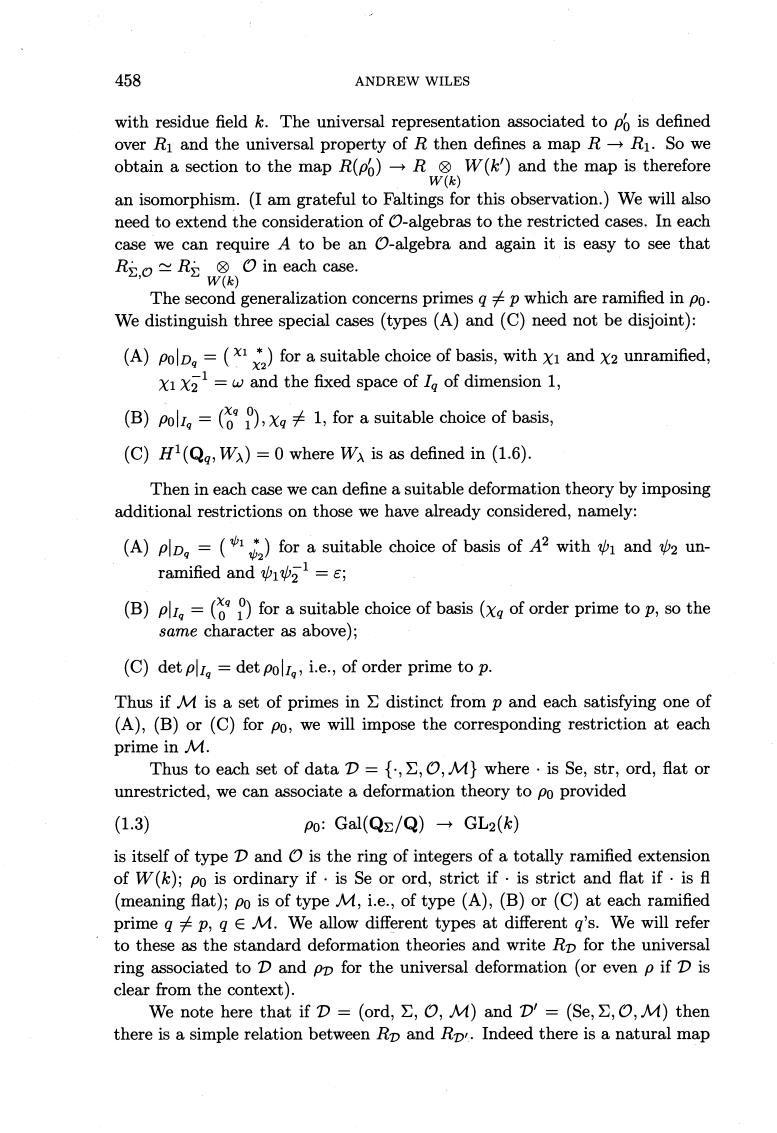正在加载图片...

458 ANDrew WILES with residue field k.The universal representation associated to po is defined over R and the universal property of R then defines a map RR1.So we section to the mapR(6)→Rw受,W and the map is an isomorphism.(I am grateful to Faltings for this observation.)We will alsc need to extend the consideration of -algebras to the restricted cases.In each case we can require A to be an O-algebra and again it is easy to see that R险O二R吃品 in each case The second generalization concerns primes gp which are ramified in po. We distinguish three special cases(types (A)and(C)need not be disjoint): (A)polD=()for a suitable choice of basis,with xi and x2 unramified, x1x2=wand the fixed space of Ig of dimension 1, (B)polr=(,1,for a suitable choice of basis, (C)H(Q,WA)=0 where Wa is as defined in (1.6). Then in each case we can define a suitable deformation theory by imposing additional restrictions on those we have already considered,namely: (A)plD=()for a suitable choice of basis of A2 with v and 2 un- ramified and吻p2=e; (B)=(for a suitable choice of basis (of order primetop,so the same ch aracter as above); (C)detpl=detpoli.e.,of order prime to p. Thus if M is a set of primes in distinct from p and each satisfying one of (A),(B)or (C)for po,we will impose the corresponding restriction at each prime in M. Thus to each set of data D={,M}where.is Se,str,ord,flat or unrestricted,we can associate a deformation theory to po provided (1.3) po:Gal(Qs/Q))→GL2() is itself of type D and is the ring of integers of a totally ramified extension of W(k);po is ordinary if.is Se or ord,strict if.is strict and flat if.is fl (meaning flat);po is of type M,i.e.,of type (A),(B)or (C)at each ramified prime gp,M.We allow different types at different g's.We will refe to these as the standard deformation theories and write Rp for the universal ring associated to D and pD for the universal deformation (or even p if D is clear from the context). We note here that if D=(ord,∑,O,M)andD'=(Se,∑,O,M)then there is a simple relation between RD and Rp.Indeed there is a natural map 458 ANDREW WILES with residue field Ic. The universal representation associated to pb is defined over R1 and the universal property of R then defines a map R + R1. So we obtain a section to the map R(pb) + R @ W(kl) and the map is therefore W(k) an isomorphism. (I am grateful to Faltings for this observation.) We will also need to extend the consideration of 0-algebras to the restricted cases. In each case we can require A to be an 0-algebra and again it is easy to see that Rc," P Rc @ 0 in each case. Wflc) \, The second generalization concerns primes q # p which are ramified in po. We distinguish three special cases (types (A) and (C) need not be disjoint): (A) polo, = ( ,*,) for a suitable choice of basis, with ~1 and ~2 unramified, xi xzl = w and the fixed space of I, of dimension 1, (B) po11, = ( yP), xq# 1,for a suitable choice of basis, (C) H1(Q, Wx) = 0 where Wx is as defined in (1.6). Then in each case we can define a suitable deformation theory by imposing additional restrictions on those we have already considered, namely: (A) plo, = ( $' ;) for a suitable choice of basis of A2 with $1 and q2unramified and $l$;l = E; (B) piI, = ( yP) for a suitable choice of basis (x, of order prime to p, so the same character as above); (C) det pi = det po 1 I, i.e., of order prime to p. Thus if M is a set of primes in C distinct from p and each satisfying one of (A), (B) or (C) for pol we will impose the corresponding restriction at each prime in M. Thus to each set of data D = {.,C, 0,M) where . is Se, str, ord, flat or unrestricted, we can associate a deformation theory to po provided is itself of type D and 0 is the ring of integers of a totally ramified extension of W(Ic); po is ordinary if . is Se or ord, strict if . is strict and flat if . is fl (meaning flat); po is of type M, i.e., of type (A), (B) or (C) at each ramified prime q # p, q E M. We allow different types at different 9's. We will refer to these as the standard deformation theories and write Rv for the universal ring associated to D and p.o for the universal deformation (or even p if D is clear from the context). We note here that if D = (ord, C,0,M) and Dl = (Se, C, 0,M) then there is a simple relation between Rv and RVl. Indeed there is a natural map